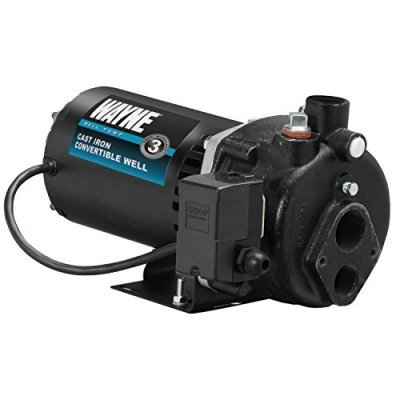Pond Pumps Canada is part of the Amazon Affiliate Network. We may receive payment for items purchased through the Amazon website.
The Wayne CWS50 1/2-Horsepower shallow well jet pump is for wells up to 90-Feet deep. At 50 PSI it pumps up to 310-Gallon per hour at 5-Feet depth. 1/2 HP Cast Iron Convertible Deep Well Pump, 3 Year Warranty.
- Pumps up to 310-Gallon per hour
- Dual voltage (120-240-Volt) high efficiency square flanged motor is factory wired for 120-Volt.
- Dedicated priming port for volute filling
- Durable cast iron volute
- 3/4-Inch NPT discharge with 1-1/4-Inch discharge and 1-Inch drive
- 1/2 hp; max. Flow rate is 408 gallons per hour; (50 psi)
- 3/4 in. Npt discharge with 1-1/4 in. Npt suction and 1 in. Drive
- Dual voltage (120V/240V) high efficiency square flange motor (factory set for 240V)
- Pressure switch is pre-set at 30-50 psi for automatic operation
- Durable cast iron volute with dedicated priming port for volute filling
Wayne CWS50 1/2-Horsepower Cast Iron Convertible Well Jet Pump
- Brand: WAYNE CWS50 1/2 HP Cast Iron Convertible Well Jet Pump for Wells
- Product Code: CWS50
- Availability: In Stock
Related Products
Flotec TC2104-P2 Well Pump Pressure Gauge
About the Flotec TC2104 Pressure Gauge for Jet/SubmersibleWe..
Flotec TC2501LF Well Pump Foot Valve
Well pump foot valve Low lead For use as inlet of suction pi..
Dynamic Head
The effect of the Earths gravity on the "lift" or head pressure is fairly simple; for every vertical foot of distance the pump moves the water you are adding one foot of head pressure so the ratio is a 1:1 ratio. The effects of the friction, caused by water as it travels through your hose or pipes, on the total head pressure is a little more difficult to calculate especially as there are slight variations in pipe friction in different hose materials and the smoothness of the inner bore. Basically. for every ten feet of pipe through which the water has to travel travel horizontally will contribute 1 foot of head height; the ratio of the pipe friction loss is a 10:1 ratio.Plumbing fixtures and bends and corners in your hose also increase the total head you must calculate to ensure the proper final volume from your pump. Every corner with a 90 degree elbow in your plumbing will add 1 foot of head pressure with a 1:1 ratio. 45 degree elbows, tees and even insert couplers can all have an impact on the final flow.
If you install a pump 40 feet away from the top of your waterfall which is 6 feet above the pump and the tubing is a single run of 40 feet horizontally then you add 4 feet of head for the tubing length (the 10:1 ratio) to the 6 foot differnetial between the pump location and the final height of the waterfall so your final total dynamic head calculation would be 10 feet. This means your final volume of water flow in this water feature or application would be the volume of flow on the performance curve that equaled the gallons per hour at 16 feet. This volume will certainly be much less than the initial volume the pump can move at an open flow or a zero head.
If in the above example your 40 feet of horizontal tubing run also required 3 elbows of 90 degrees then an additional 3 feet of theoretical head would be added and your final flow result would be at 19 feet on the performance curve of the pump. In this example you would want to choose a pump that has the desired GPH rating at 9 feet of head pressure. Tubing size is also an important factor in accounting for head pressure loss, in general you should never reduce the diameter of the tubing below what the output size of the pump is, this will drastically increase head pressure, and reduce pump performance. For maximum pump performance, using the largest tubing that is practical is the best choice. A best practice is to use a hose with an inner diameter that is the same as your pumps outlet fitting.

